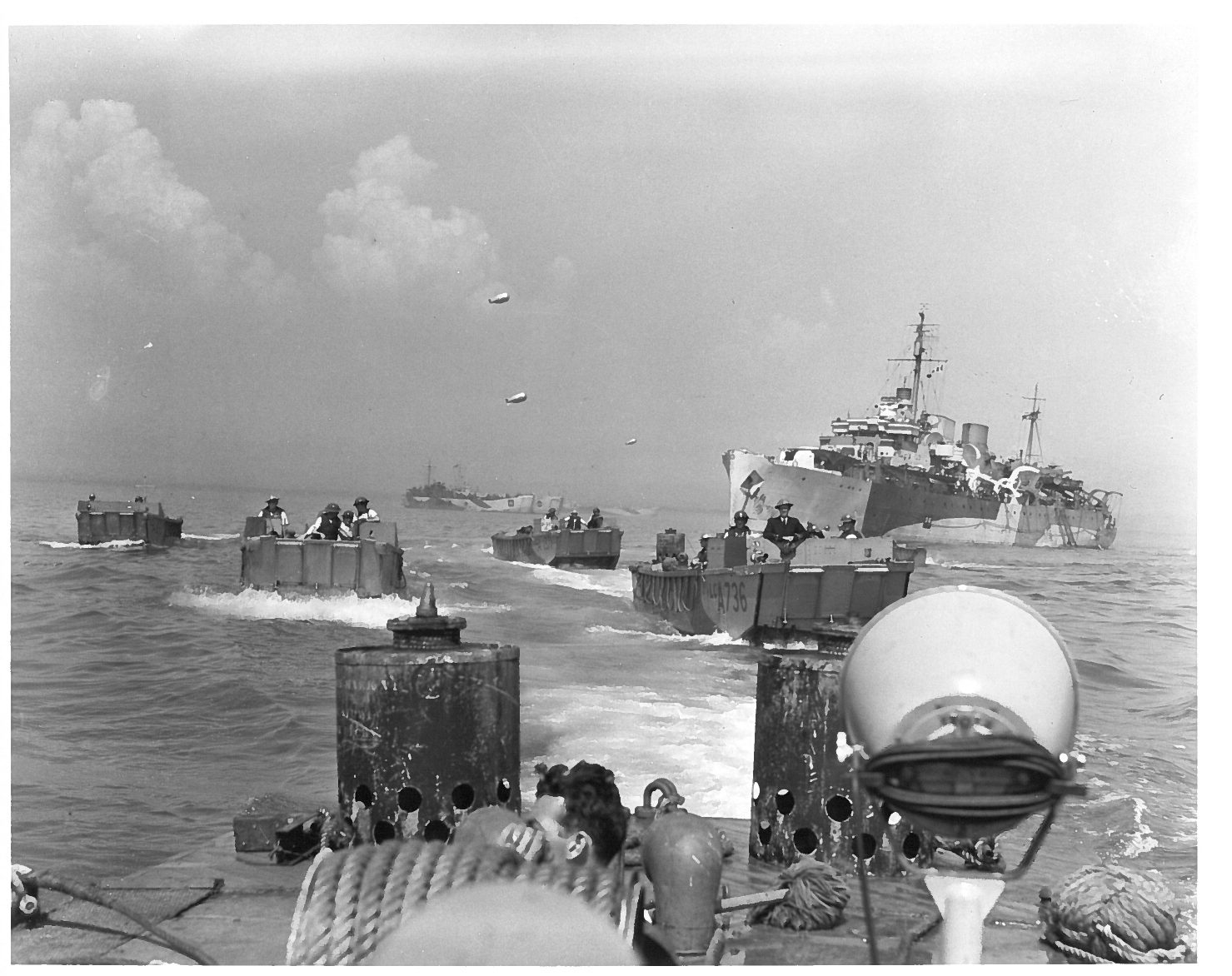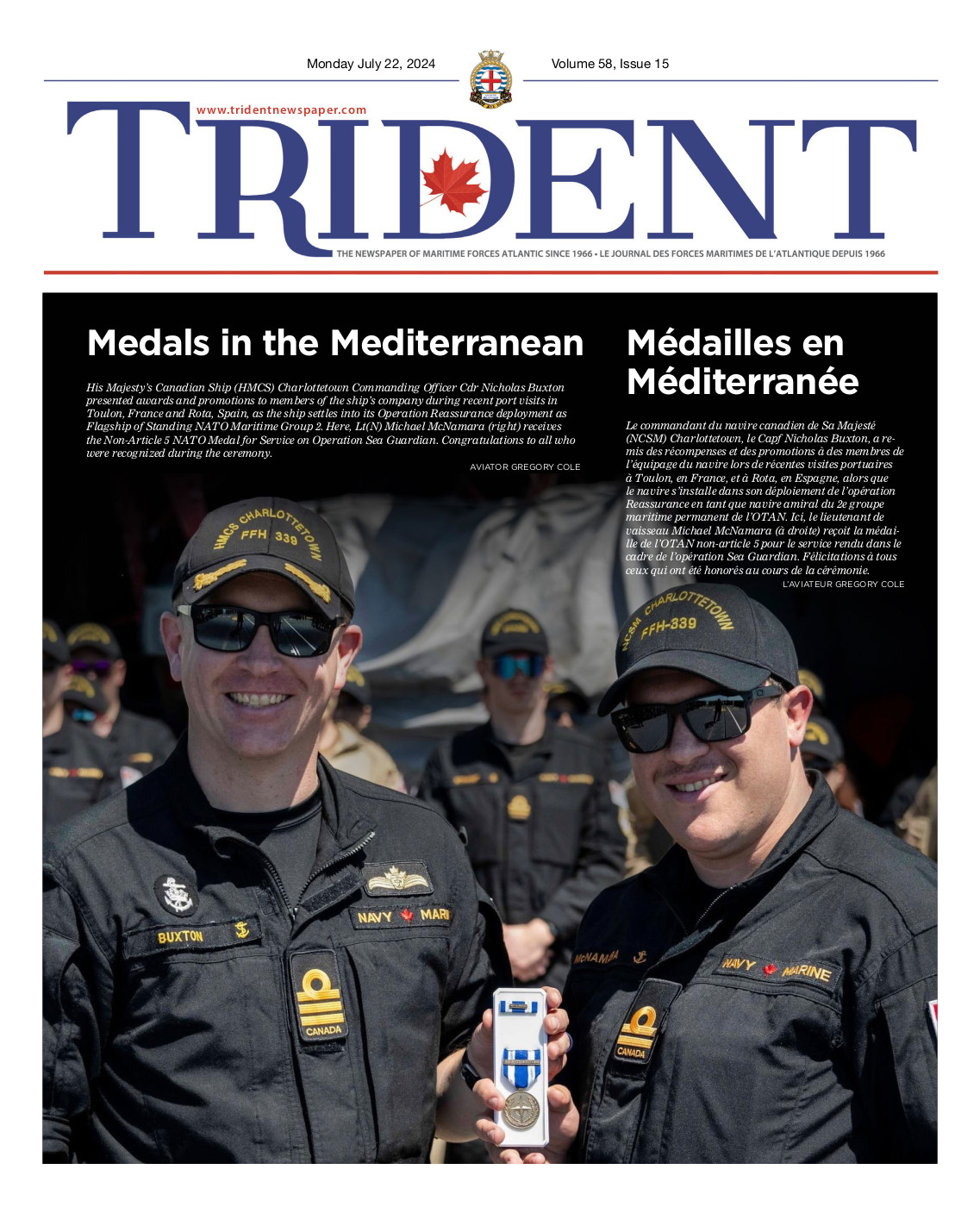
DND/PUBLIC ARCHIVES CANADA
Key events of the Battle of the Atlantic: June
By CPO1 (ret’d) Pat Devenish,
Canadian Naval Memorial Trust
June 1, 1940 – The Newfoundland Escort Force (NEF) is established to provide escort protection across the entire western Atlantic Ocean. Based out of St. John’s, Newfoundland, escorts are directed from this, the western terminus to provide cover for convoys to a point in the mid-Atlantic where they are turned over to the Royal Navy. Though Canadian commanded (by Cmdre Leonard Murray), the Force consisted as well of British, Norwegian, French, Polish and Dutch vessels. Referred to as the Iceland Run, in 1942 it was reconstituted as part of the Mid Ocean Escort Force (MOEF).
June 3, 1940 – With the fall of Denmark, the island of Greenland becomes a concern to the Allies; Would the island be turned over to Germany following the invasion of Denmark? Canada’s interests lay in the fact that Greenland’s close proximity to Canada and its position in line with convoy routes presents a possible threat. As the main supplier to the Allies of cryolite, used to manufacture aluminum, Greenland also holds a great strategic worth. In a war of words, boardroom conflicts arise between the U.S. and Canada and England. Canadian government officials suggest a small occupation force to forestall any German landing. The U.S. State department emphatically disagrees while the British feel some sort of action is necessary. When all is said and done, to appease all, Canada’s Greenland invasion force comprises the Hudson Bay Supply Vessel Nascopie, one artillery officer(in civilian dress), two uniformed RCMP constables to act as interpreters, four more for various duties and a 4″ coastal battery. By 1941, the Americans would take over by arming local inhabitants and in 1942, a troop of U.S. Army regulars settled in until war’s end.
June 12, 1940 – Just after dawn, the destroyers HMCS Restigouche and St. Laurent come under fire from a German shore battery off the French coast. In the early morning light, both destroyers exchange fire with the Germans and so for the first time in the war, Canadian ships engage the enemy.
June 13, 1940 – RAdm L.W. Murray arrives in St. John’s to take command of the Newfoundland Escort Force. From his Headquarters in the Newfoundland Hotel, with U.S. Admiral A.L. Briscoe operating out of Argentia, the coordination of all escorts, convoy routes and maritime aircraft is carried out. By 1943, the Americans would withdraw their authority in this area and by early 1944, from his new offices in Halifax, Admiral Murray would assume command of all ships escorting the North America/United Kingdom convoys as well as the hunter-killer groups of ships and aircraft on the western side of the North Atlantic.
June 15, 1940 – The Canadian merchantman Erik Boye is torpedoed and sunk by U-38 southwest of England while part of the eastbound convoy HX-48. Although there is no loss of life, the ship has the dubious honour of being the first Canadian flagged merchant vessel to be sunk in the Battle of the Atlantic.
June 21, 1940 – In Europe, France falls to a massive German onslaught. French port facilities along the English Channel are now open to the German U-boat fleet, giving them better access to the Atlantic, increasing the threat to the convoys plying the North Atlantic waters between Canada and Britain.
June 25, 1940 – HMC Ships Fraser and Restigouche are ordered to stand off the coast of St. Jean-de-Luz in the Bay of Biscay near the French-Spanish border to evacuate soldiers and civilians. In the ensuing rush to exit the area due to the armistice signed by the Vichy government, Fraser collides with the cruiser HMS Calcutta, severing Fraser just forward of her bridge. Fraser later sinks along with 47 of her crew and a loss of 19 of the Calcutta’s crew. Fraser would be the RCN`s first ship lost in the Second World War.
June 23, 1942 – A Lockheed Hudson with RCAF No. 11 Bomber Reconnaissance Squadron spots a German U-boat on the surface dead in the water, just south of Halifax. As the submarine crash dives, four depth charges rattle the engine mounts and machinery loose but U-87 escapes and limps home to be sunk less than a year later by HMC Ships St. Croix and Shediac.
June 28, 1942 – On a clear evening in the western Caribbean, the Canadian merchantman Mona Marie is sunk by surface fire from U-126. Her entire crew is able to get off before the sinking and survives.
June 1, 1943 – War strikes close to home as for the first time, enemy laid mines are sighted in the waters off the approaches to Halifax harbour.
June 3, 1944 – On her first patrol, U-477 is sunk by RCAF Flight Lieutenant MacBride west of Trondheim, Norway flying his Consolidated Canso out of Wick in Northern Scotland. Although intense flack is encountered, the aircraft suffers minimal damage as the attack is pressed on.
June 6, 1944 – D-Day, the invasion of German-occupied Europe, is launched across a stretch of beach on the Normandy coastline just north of Caen, France. Thirty thousand men with the 3rd Canadian Infantry Division are tasked with one of five beaches, code named JUNO, targeted by the Allies in the dawn assault. Between the seaside communities of Courseulles sur mer and Ste. Aubin sur mer, members of the Canadian Scottish Regiment, the Royal Winnipeg and Regina Rifles as well as the North Shore (New Brunswick) Regiment, Queen’s Own Rifles and the Regiment de la Chaudiere lead the assault with the North Nova Scotia Highlanders, Highland Light Infantry of Canada and the Stormont, Dundas and Glengarry Highlanders in reserve. They are in turn supported by the 1st Hussars tanks, the Fort Garry tanks and the Sherbrooke Fusiliers in reserve. Meanwhile, offshore, sixteen RCN minesweepers are tasked with clearing a path to the American beaches, UTAH and OMAHA. Offshore of JUNO, HMC Ships Algonquin and Sioux, along with 11 other destroyers, 11 frigates and 19 corvettes as part of Operation NEPTUNE add their guns to the many others softening up the German defences. Overhead, Spitfires of the RCAF’s No. 127 Wing ensure air supremacy over JUNO during the entire assault and only on two occasions are German aircraft able to penetrate to the beach head. Although none of the Allied units would reach their objectives for the day, the 3rd Canadian Infantry Division is the closest holding a parcel of land roughly 5 miles wide by 7 miles deep. Total Canadian casualties are considered to be light for an assault of this magnitude, with just 359 killed and 715 wounded, compared with 907 dead and 2460 wounded at Dieppe two years previously.
June 7, 1944 – HMC Ships Huron and Haida join Force 27 off the coast of France and are immediately dispatched to engage three German destroyers. In the on again-off again battle over the proceeding days, fierce action sees one of the German destroyers run aground off Ill de Bas under heavy fire. Another is sunk, and the third limps away after being severely damaged. Although a relatively small action in the large scale of the D-Day landings, it serves to remove a major threat to surface craft transiting the Channel in the days following the Normandy landings.
June 8, 1944 – Just two days after D-Day, the Germans have mustered a sizable number of U-boats off the Normandy coast in an attempt to stem the flow of supplies reaching the Allies in their advance into France. Canadian Flying Officer K.O. Moore piloting his Liberator bomber from RAF Coastal Command 224 Sqn on anti-submarine patrol engages two U-boats, one right after the other on the moonlit night, sinking both with depth charges inside a span of 22 minutes. For his efforts, he is awarded the DSO(Distinguished Service Order) and the U.S. Silver Star. Post war inspection of German records indicate the two submarines to be U373 and either U629 or U441.
June 10, 1944 – The frigate HMCS Teme is almost cut in two during a collision with the aircraft carrier HMS Tracker in the fog of the English Channel while prosecuting an ASDIC contact. Teme loses four of her crew and is out of action. She is towed to Cardiff in England by HMCS Outremont and remains out of commission until February 1945.
June 13, 1944 – A Consolidated Canso out of Wick, Scotland with RCAF No.162 Bomber Reconnaissance Squadron, piloted by Wing Commander Bill Chapman, sights a suspected periscope from a U-boat while patrolling west of the Shetland Islands. Although he conducted a near perfect four depth charge straddle of the submarine, surface fire from the submarine’s conning tower set the Canso’s port engine afire. Chapman settled the plane down on the waves and the crew is rescued, but not before two succumbed to exposure. Nevertheless, U-715 becomes the fourth submarine sunk by No.162 Squadron.
June 18, 1944 – The Canadian merchantman Albert C. Field is sunk by marauding Luftwaffe aircraft in the English Channel, losing 4 of her crew of 33. She had departed Wales for the Normandy beachhead with 2,100 tons of munitions and 1,300 bags of mail.
June 24, 1944 – A Canso flying boat with RCAF No.162 Squadron, piloted by Canadian Flight Lt David Hornell from Toronto, sights a surfaced U-boat on the return leg of their patrol in the northern waters of the English Channel off Scotland. On their attack run, the Canso’s starboard engine is hit by small arms fire from the submarine and bursts into flames. Instead of calling off the attack, Hornell continues on his run, surprising the U-boat crew. Depth charges straddle the submarine and it sinks within minutes, but Hornell also loses the battle with the struggling aircraft and it plunges into the sea. Although the crew all escape, three are unable to survive the 24 hours in the water before help arrives. The last to go is Hornell himself who is posthumously awarded the last Victoria Cross won by an RCAF airman in the War.
Also on this day, the combined efforts of HMCS Haida, HMS Eskimo and a Czech-crewed B-24 Liberator with RAF Squadron 311 leave U-971 foundering on the surface just west of the English Channel to later sink. Of 52 crew, all but one are rescued.
June 4, 1945 – Although the war in Europe has been over for weeks, confusion and communication problems prevent confirmation of this fact to several patrolling German U-boat crews. Finally, however, on this day, the U-boat war is declared officially over. For the first time in six years, ship’s lights go back on and the convoy system is disbanded.





